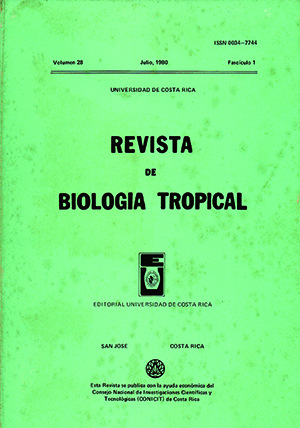Abstract
Lichens were used as air pollution indicators in the metropolitan area of San Jose, Costa Rica. Trasplants showed a positive correlation between the percentage of dead cells in the thallus and the ketone soluble substances deposited on it. Those parts of the city where pollution is greatest (industrial areas and heavy traffic) were also the ones where lichens suffered the most, and in some extreme cases the thallus died after 8 months of exposure. Besides this transplant experiment, the coverage of Parmelia lichens on the bark of several tree species was determined in some areas of the city. The results of these observations suggest that the city of San José has three different kinds of air environment in relation to lichen survival: normal, transitional and desertic, as reported for other cities of the world. The most frequent air pollutants in San José are: CO, C02 , C2H5OH, Cl2, HCI, H2S, H3PO4, H2CrO4, NO, NH3, NH4 Cl, SO2 and Zn.
References
Barkman, J.J. 1969. The influence of air pollution on bryophytes and lichens, p. 197-209. In Centre for Agricultural Publishing and Documentation, Proceedings of the First European Congress on the influence of air pollution on plants and animals. Wageningen, Holanda.
Barkman, J.J., F. Rose, & V. Westhoff. 1968. The effect of air pollution on non vascular plants, p. 237-241. In Centre for Agricultural publishing and Documentation, Proceedings of the First European Congress on the influence of air pollution on plants and animals. Wageningen, Holanda.
Bishop. J.A., L.M. Cook, J. Muggleton, & M.R.D. Seaward. 1975. Moths, lichens and air pollution along a transect from Manchester to North Wales. J. Appl. Ecol., 12: 83-98.
Boertitz, S., & H. Ranft. 1972. Zur SO2 und HF Empfindlichkeit von Flechten und Moosen. Biol. Zbl., 91: 613-623.
Brodo, I.M. 1961. Trasplant experiments with corticolous lichens using a new technique. Ecology, 42: 838-841.
Brodo, I.M. 1966. Lichen growth and cities; a study on Long Island, New York. Bryologist, 69: 427-449.
Brown, R. T. 1974. Fumace fuel, air pollution accumulated in snow and lichen growth on trees. Mich. Acad. Sci., 7: 149-156.
Bystrek, J. 1974. Wrazliwosc porostow n a zanieczyszczenia atmosferyczne. Ann. Univ. Mariae Curie Slodowska. Sect. C. Biol., 29: 413-420.
Daly, G.T. 1970. Bryophytes and lichens as indicators of air pollution in Christchurch, New Zealand. Ecol. Soc. Proc., 17: 70-79.
Gilbert, O.L. 1969. The effect of SO2 on lichens and bryophytes around Newcastlc-Upon-Tyne, p. 223-235. In Centre for Agricultural Publishing and Documentation Proceedings of the First European Congress on the influence of air pollution on plants and animals. Wagcningen, Holanda.
Hawksworth, D.L. 1971. Lichens as litmus for air pollution: A historical review. Int. J. Environ. Stud., 1: 281-296.
Hawksworth, D.L., & F. Rose. 1970. Qualitative scale for estimating sulphur dioxide air pollution in England and Wales using epiphytic lichens. Nature (London), 227: 145-148.
Hin, D.J. 1974. Some effects of sulphite on photosynthesis in lichens. New Phytol., 73: 1193-1205.
Le Blane, F., & D.N. Rao. 1966. Réaction de quelques lichens et mousses épiphytiques a l'anhydride sulfureux dans la région de Sudbury, Ontario. Bryologist, 69: 338-346.
Le Blane, F., & D.N. Rao. 1973. Evaluation of the pollution and drought in relation to lichens and bryophytes in urban environments. Bryologist, 76: 1-19.
Le Blanc, F., G. Comeau, & D.N. Rao. 1971. Fluoride injury symptoms in epiphytic lichens and mosses. Can. J. Bot., 49: 1691-1698.
Leitz, W. 1972. Flechtenwuchs und Luftverunreiningung im Grossraum von Saarbruecken. Bert. Deutsch. Bot. Ges., 85: 239-247.
Mudd, J.B., & Kozlowsky, (eds.) 1975. Responses of plants to air pollution. Academic Press. 383 p.
Nash, T.H. 1973. Sensitivity of lichens to sulphur dioxide. Bryologist, 76: 333-339.
Olkkonen, H., & K. Takala. 1975. Total sulphur content o f an epiphytic lichen as an index of air pollution and the usefulness of the x-ray fluorescense method in sulphur determinations. Ann. Bot. Fenn., 12: 131-134.
Pisut, I., & Eva Lisicka-Jelinkova. 1974. E p iphytische Flechten in der U mgebung einer aluminum huette in der Mittelslowaekei. Biología (Bratisl.), 29: 29-38.
Rao, D.N., & F. Le Blanc. 1967. Influence of an iron sintering plant on the epiphytic vegetation in Wawa, Ontario. Bryologist, 69: 69-75.
Seaward, M.R.D. 1973. Lichen ecology of the Scunthrope Heathlands: I. Mineral accumulation. Lichenologist, 5: 423-433.
Sundstrorn, K.R., & J.E. Hallgren. 1973. Using lichens a s physiological indicators of sulfurous pollutants. Ambio, 2: 13-21.
Varesehi, V., & E. Moreno. 1973. La contaminación en Caracas en los años 1958-1973. Bol. Soc. Venezolana de Ciencias Nat., 30: 387-444.
##plugins.facebook.comentarios##

This work is licensed under a Creative Commons Attribution 4.0 International License.
Copyright (c) 1980 Revista de Biología Tropical


